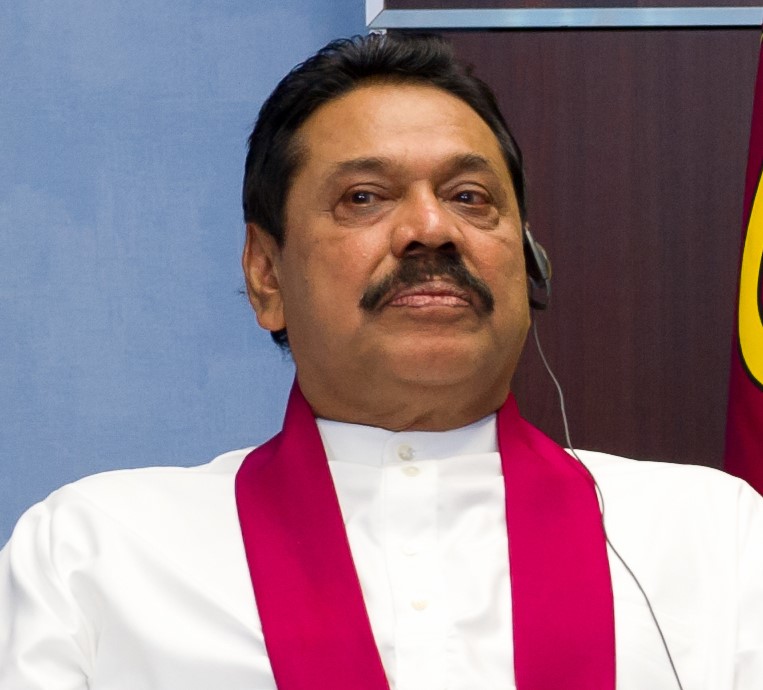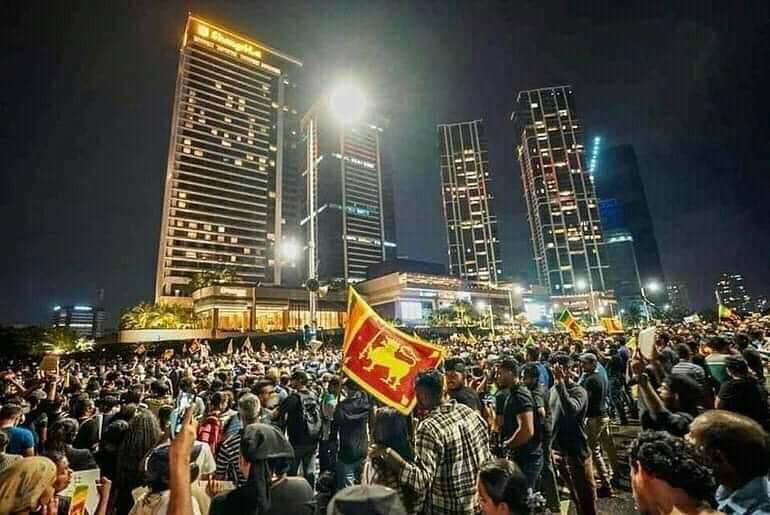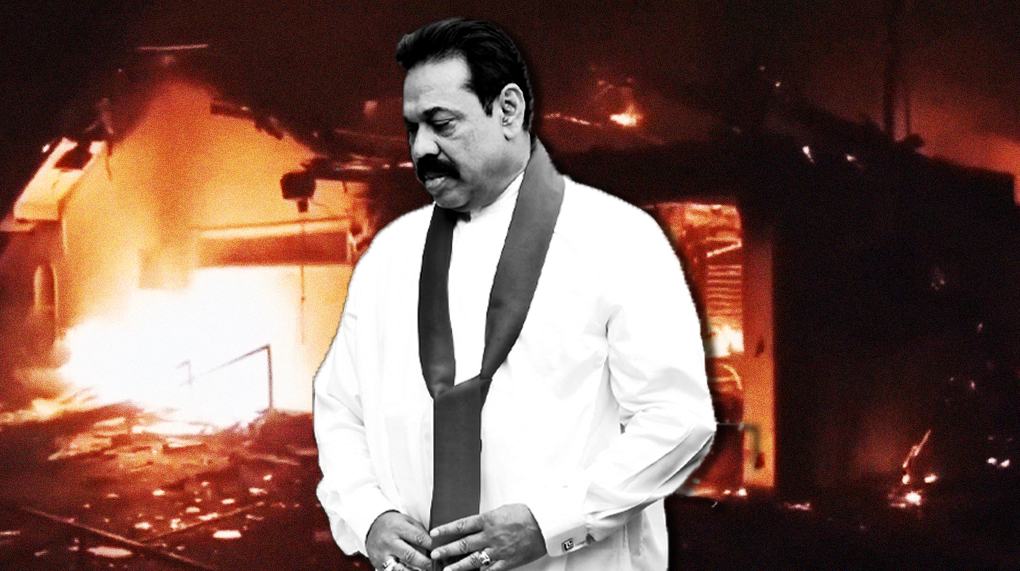On Monday 9 May, dramatic events rocked Sri Lanka. After months of economic turmoil, and weeks of mass mobilisations on the streets, Prime Minister Mahinda Rajapaksa made a desperate gamble to establish order and save his own political skin. But his brutal crackdown backfired in dramatic style. By nightfall, Mahinda was hiding in a naval base, whilst dozens of MPs’ residences were in flames. By the end of the day, eight people were dead including one MP and two police officers, and the hospitals were flooded with the injured.
This is an important ‘before and after’ moment for the struggle. The more moderate layers have been left in a state of shock by the incidents of 9 May. Meanwhile, some of the self-appointed ‘leaders’ are preparing to sell a compromise.
The most advanced layers of youth must not allow the lessons of these dramatic days pass by unlearned.
Mahinda’s last role of the dice
The enormous, elemental movement of the masses in Sri Lanka has now been ongoing for more than six weeks. As it has unfolded, the Rajapaksa brothers – President Gotabaya Rajapaksa and Prime Minister Mahinda Rajapaksa – could clearly see that they weren’t both going to get out of this with their political hides intact. Each has sought their own self-preservation at the other’s expense.
 When Gota demanded Mahinda’s (pictured above) resignation, Mahinda decided that now was the time to strike, to unleash his thugs – this however backfired spectacularly / Image: Alexander Nikiforov, Wikimedia Commons
When Gota demanded Mahinda’s (pictured above) resignation, Mahinda decided that now was the time to strike, to unleash his thugs – this however backfired spectacularly / Image: Alexander Nikiforov, Wikimedia Commons
So on Friday, when Gota demanded Mahinda’s resignation, the latter was certainly not prepared to go quietly. Mahinda calculated that after more than a month on the streets, the movement was running out of steam by now. He decided that now was the time to strike, to unleash his thugs, and that once he cleared the movement off the streets there would be no need for him to resign at all! This is a valuable insight into the psychology of these gangsters.
On Monday 9 May, he put his plan into action. But as Marx once explained: “Revolution sometimes needs the whip of counter-revolution to push it forward.”
Mahinda’s counter-offensive backfired in spectacular fashion.
The violence of the counter-revolution
With powerful connections from his time in the presidency between 2005 and 2015, Mahinda was well placed to stage an unofficial crackdown. On Monday 9 May, utilising these links to the state and his substantial following of loyal goons, he prepared a showdown with the movement.
In the morning, lumpen gangs were bussed to a pro-government rally hosted by himself and his son and princeling of the Rajapaksa family, Namal, at the official Prime Ministerial residence at Temple Trees in Colombo. The paid attendees were plied with alcohol, then whipped up into a mob.
Then, to chants of “we need Mahinda,” they were sent from Temple Trees down to the permanent anti-government encampments a few hundred yards away: first to ‘Maina Go Gama’ opposite Temple Trees itself, and then a few hundred metres away to ‘Gota Go Gama’ at Galle Face Green.
"We need Mahinda" massive crowd inside Temple Trees urging Prime Minister to not to resign pic.twitter.com/oTn778l0aS
— NewsWire 🇱🇰 (@NewsWireLK) May 9, 2022
This was a well-coordinated and vicious assault. Hundreds of goons were brought in by the busload. Most were lackeys of the regime, although a number of prisoners were brought from the jails to riot for the day. Meanwhile, orders had been given to the police not to obstruct this pro-government mob but to step aside and let them create havoc.
The result was a brutal orgy of violence. Videos were soon circulating on social media of anti-government protesters being beaten with planks and sticks. Another showed pro-government thugs ripping the hijab off a Muslim woman and beating her to the ground. The tents of the occupation were trampled and torched, with similar scenes witnessed at ‘Gota Go Gama’ in Kandy, a city in the centre of the island.
Footage of Government supporters assaulting protester at "GotaGoGama" pic.twitter.com/nAxkbQi1nX
— NewsWire 🇱🇰 (@NewsWireLK) May 9, 2022
Beating an unarmed woman right in front of more than a dozen of policeman. Wtf 🤬 pic.twitter.com/uuc8WO3FV5
— Videha Dhothaka (@dhothaka) May 9, 2022
The people fight back
The counter-revolutionary violence swiftly ignited a powder keg of indignation and anger.
As the news spread, angry masses descended on the green from nearby road blockades that had been ongoing in protest at the lack of cooking gas. Workers left their workplaces in large numbers to come to the movement’s defence. The trade unions and student unions also put the call out for their members to go down to the sites of the attacks.
The masses fought back fiercely. Galle Face Green was quickly reclaimed.
From Temple Trees, pro-government goons fled into the shallow waters at the edge of Beira Lake. Only as night fell did the police (reluctantly) fish them out of the dirty water.
Supporters of the Prime Minister blocked by protesters after they jumped to Berawewa pic.twitter.com/7lbrr3hjER
— NewsWire 🇱🇰 (@NewsWireLK) May 9, 2022
Soon, the buses that had been used to bring prisoners and SLPP goons down to the protest sites were burnt out and smashed up. In one case a bus was dumped in a lake, whilst another was smashed using a JCB digger!
More buses which carried Rajapaksa supporters to Colombo attacked pic.twitter.com/afZ9bAGU20
— NewsWire 🇱🇰 (@NewsWireLK) May 9, 2022
Outside of Colombo, the eruption of anger was even more fierce. The masses’ full fury was directed at the ministers and MPs of this thieving government. An island-wide police curfew was declared but the masses remained undaunted. For their part, the police did little to stop the anti-government masses from staging their counter-attack.
It is clear that in the morning, the rank-and-file of the police were under orders to stand aside as the lumpen thugs smashed up ‘Gota Go Gama’. No doubt many reluctantly followed orders, and now took satisfaction in the masses’ counter-attack. Indeed, in at least one place police officers even joined the protest.
The ruling party, the SLPP, had sowed the wind and reaped the whirlwind. Its offices were completely smashed to pieces. Every symbol of the ruling party was destroyed. A statue of the Rajapaksa patriarch was toppled. One minister’s jeep was thrown in a lake. In another case, an MP’s collection of Lamborghinis was torched.
Everywhere, the residences of ruling party MPs and government ministers were under siege by large anti-government protests. By evening, at least twenty to twenty-three such residences were smouldering ruins, burned to the ground by the masses – including the ancestral home of the Rajapaksa family itself.
The house of Government MP Sanath Nishantha who led a mob to attack Galle Face protesters completely destroyed pic.twitter.com/p1PpaGOgE2
— NewsWire 🇱🇰 (@NewsWireLK) May 9, 2022
Update: Johnston Fernando's residence in Kurunagala set on fire. pic.twitter.com/w1IqOiXEWF
— DailyMirror (@Dailymirror_SL) May 9, 2022
Ancestral home of the Rajapaksa family in Medamulana, Hambantota set on fire by protesters. pic.twitter.com/QIEnREphjq
— NewsWire 🇱🇰 (@NewsWireLK) May 9, 2022
In the midst of the confusion, certain fears naturally circulated of agents provocateurs setting the fires. Is this likely? The way events unfolded would suggest not – firstly, it is doubtful that a bloody nose on such a scale was self-inflicted by the regime.
Secondly, were provocateurs at work on any serious scale, it would presumably be towards some end, such as providing the pretext for a coup.
But, as the instances of relative police passivity suggest, the ruling class cannot reliably rest on the armed bodies of the state – at least, not at this time. On Tuesday, the senior police officer who had collaborated with Mahinda’s riot a day earlier found himself surrounded and beaten by an angry anti-government crowd. Again, his officers failed to intervene to protect their own commander!
A coup or some other such intervention by the army at this time would be a very risky manoeuvre indeed! It could end disastrously for the regime, bringing the masses out in enormous numbers and causing the army to break down on class lines.
Mahinda out
As the full scale of the masses’ rage became evident, Mahinda Rajapaksa was not only forced to submit his resignation – he was forced to flee for his life!
Following his lead, government ministers began resigning. But the masses weren’t going to let them get away so easily. Road blockades were established on the highways and outside the airport to prevent MPs from trying to escape the country. Even police cars were stopped and checked by the people! When the car of one ruling party MP was blocked on a highway between Colombo and Kandy, he opened fire on protesters, killing one and injuring others. After trying to flee to a nearby building, he committed suicide, turning the gun on himself.
When it became known that Mahinda Rajapaksa was holed up at the highly fortified Trinco naval base, large crowds surrounded all its entrances. Many even took to boats to go around the base to ensure no private yacht carrying the former Prime Minister could escape the island! This movement has taken on breathtaking insurrectionary features across the entire country. And reflecting the sheer pressure from below, 2,000 trade unions called an all-out general strike.
But the call for a general strike was short lived. The explosive anger of the movement soon rattled the more moderate and middle-class elements, who have pulled back in fright – the trade union leaders among them.
Self-defence
Monday’s dramatic events mark a fundamental turning point in the situation.
From day one, the movement has insisted upon its strict adherence to non-violence. It was the sincere hope of the overwhelming majority of the people that the Rajapaksas could be ousted peacefully. After Monday’s events, huge numbers of workers, peasants and young people could clearly see that this is no longer tenable.
 The movement has insisted upon its strict adherence to non-violence – after Monday’s events, huge numbers of workers, peasants and young people could clearly see that this is no longer tenable / Image: Surekha Samarasena, Wikimedia Commons
The movement has insisted upon its strict adherence to non-violence – after Monday’s events, huge numbers of workers, peasants and young people could clearly see that this is no longer tenable / Image: Surekha Samarasena, Wikimedia Commons
However, as night fell on Monday, some of the middle-class layers in the movement, particularly on social media, began succumbing to nervousness. Terrified by the anger that the counter-revolution had provoked, they pleaded with the masses to return to the movement’s peaceable methods.
But had the people failed to come out en masse after Mahinda’s goons had attacked ‘Maina Go Gota’ and ‘Gama Go Gota’, the violence would have been far, far worse. Rather than the ‘violence’ of self-defence, the regime – having tasted blood and sensed weakness – would have gone in for the kill. They would have unleashed a reign of terror involving massive counter-revolutionary repression and the incitement of communal killings.
The response of the masses prevented that. As has always been the case in history, it is the counter-revolution that once again initiated violence. What we saw from the masses was self-defence. And self-defence is not only justified – it is absolutely necessary. What it is lacking is organisation and a clear programme. This is what gave Monday’s outbreak a convulsive character.
No, we cannot condemn the ‘violence’ of the masses. In the face of counter-revolutionary violence, self-defence is absolutely necessary. And the bloody nose the regime received will force them to move more carefully in future.
Leadership and programme
What is needed is clear organisation: committees of struggle and self-defence in the workplaces and communities, linked up on the district and national level. But more than this – and as a prerequisite of this – the movement needs clear leadership and a clear programme! This is precisely what it is lacking.
Up until now, the movement has, quite understandably, eschewed political parties – rejecting all of them in disgust and anger. But nature abhors a vacuum. Eventually, leadership must emerge. And indeed, a kind of leadership has emerged.
The failure of the trade union leaders to mobilise meant their abdication of the leadership of the movement. In their place, middle-class layers took up a position of predominance in the occupations and in the movement at large.
But these self-appointed, middle-class ‘leaders’ have actively sought to prevent the discussion of any political or economic programme for the movement. They have effectively sought to maintain the movement in its earliest, most ‘spontaneous’ form, preventing the masses from clarifying essential questions. This has caused mass confusion on matters of fundamental importance.
With the leadership preventing a democratically decided upon programme emerging from the movement, accidental groups have inevitably stepped forward with their own ideas.
With its prestige running high because of the powerful role the lawyers have played in the movement, the Bar Association of Sri Lanka (BASL) has stepped forward with a programme that it claims can offer a way out of the crisis. But this ‘programme’ represents a complete sell out to the ruling class.
Their proposal calls for the formation of an interim national unity government of all the parties, with Gotabaya Rajapaksa still in power for four to six months! This government will (we are told) return the country to a prime ministerial system, after which the country will go to the polls to elect a new government.
And are the masses to remain on the streets for six months to ensure such an interim government honours its promises? To pose the question is to show the absurdity of this proposal.
Worse than this, BASL explains that such a government should also be tasked with seeking assistance from the IMF and other imperialist creditors. Confusion about the meaning of an IMF bailout is presently widespread in the movement, principally for a lack of a clear, socialist leadership able to explain the real character of imperialism.
BASL’s programme even calls for more involvement for the chambers of commerce in the parliamentary process! i.e. direct representatives of the same capitalist class who have brought such a catastrophic situation to Sri Lanka in the first place!
For an organisation enjoying prestige in the movement to present such a programme is manna from heaven for the ruling class.
Where next?
After the 9 May incidents, the more moderate elements were left in a state of shock. They continued to harbour the utopian hope that the movement can succeed entirely peacefully through purely legal channels.
Meanwhile, the latest information is that Gota has attempted to implement the BASL proposals, having appointed Ranil Wickremesinghe – the sole MP of the right-wing UNP – as Prime Minister.
But it is not at all clear that these measures will successfully defuse the movement.
Firstly, the main objective of the movement is not yet achieved: Gota remains in power! Secondly, it’s not certain that the parties in parliament will even be able to arrive at an agreement themselves! The latest information is that both the SJB and the JVP have now said they will not join such a government. This will not be a step towards ‘national unity’ but will be a continuing government of crisis.
And finally, the opposition is just as hated as the ruling party. It is unlikely that the masses will be placated by any such reshuffling at the top, even if the opposition can be brought on board. On Monday, it was noteworthy that SJB leader Sajith Premadasa was chased off under a barrage of kicks and insults when he tried to visit ‘Gota Go Gama’.
It is clear that BASL, despite its authority, does not speak for the whole movement, and it will have extreme difficulty in selling such a compromise. Among the more radical lawyers, voices of dissent have started to be raised against the attempted sell-out. The Young Lawyers Association for instance has demanded that BASL at the very least include Gota’s resignation to its demands and that it reject the IMF bailout.
But whether the movement continues to move ahead, or temporarily ebbs as a result of the confusion sowed by some frightened middle-class leaders, it is clear that a turning point has been reached. The first serious test of the movement has exposed its weaknesses: its lack of programme and organisation, and the inadequacy of its self-appointed ‘leaders’.
And should a new government open the road for an IMF bailout, the masses will receive another bitter lesson about the real nature of the imperialists’ medicine.
It is time for the most class-conscious, revolutionary elements in the movement to learn the lesson and prepare for the next major test. That lesson is principally this: the most pressing task is the formation of a revolutionary party with a clear socialist programme. In the present situation, such a party would grow rapidly as its prognoses are confirmed by events and the masses learn for themselves the impossibility of solving their problems on a capitalist basis. In turn, a revolutionary party would cut through the confusion that presently exists in the movement and open the road to the struggle for power by the Sri Lankan working class.

